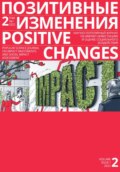
Редакция журнала «Позитивные изменения»
Позитивные изменения. Том 4, №1 (2024). Positive changes. Volume 4, Issue 1 (2024)
• Оценка является неотъемлемой частью деятельности организации. Разработаны и приняты политика и процедуры оценки, принята стратегия, разработан план проведения оценки, определены процессы, должностные обязанности и распределена ответственность между сотрудниками, проводится обучение сотрудников, мониторинг и оценка – обязательный компонент каждого проекта организации.
• Сотрудники организации обладают всеми необходимыми компетенциями для проведения оценки и/или организации проведения оценки, проводится регулярное обучение сотрудников.
• В организации выделяются и постоянно используются ресурсы, необходимые для проведения оценки.
• Сотрудники организации мотивированы проводить оценку, участвовать в оценке, использовать результаты оценки.
• Результаты оценки обсуждаются и используются для принятия управленческих решений, направленных на улучшение программ и проектов.
Для анализа возможного влияния оценки на благополучие сотрудников НКО мы будем использовать модель[42], разработанную компанией Indeed, владеющей самым посещаемым в мире сайтом по поиску работы (более 350 миллионов уникальных посетителей в месяц). С помощью специального индекса Work Wellbeing Score соискатели могут получить информацию об уровне корпоративного благополучия (высокий, средний, низкий) в компаниях-работодателях.
Модель складывается из 4 главных характеристик: счастье, стресс, удовлетворенность и ясность цели, а также 12 драйверов корпоративного благополучия:
1. Достижения: «Я достигаю большинства своих целей на работе».
2. Принятие: «На работе люди ценят меня как личность».
3. Принадлежность: «Я чувствую принадлежность к своей компании».
4. Энергия: «При выполнении большинства рабочих задач я чувствую прилив энергии».
5. Справедливая оплата: «За мою работу мне платят справедливо».
6. Гибкость: «Моя работа допускает достаточную гибкость и по времени, и по месту».
7. Инклюзивность: «В моей рабочей среде чувствуется инклюзивность и уважение ко всем людям».
8. Социальная значимость: «Моя работа важна для решения социально значимой задачи».
9. Обучение: «Я постоянно чему-то учусь на работе».
10. Поддержка руководителя: «Мой руководитель помогает мне добиться успеха».
11. Поддержка коллег: «На работе есть люди, которые оказывают мне поддержку и воодушевляют меня».
12. Доверие: «Я могу доверять людям в моей компании».
На наш взгляд, этот перечень является самым полным и охватывает практически все факторы корпоративного благополучия, которые упоминаются в различных публикациях. Кроме того, формулировки в форме «я-сообщений» очень удачно проясняют смысл каждого драйвера.
В Таблице 2 описан возможный характер влияния оценки на каждый из драйверов, а также степень этого влияния. Сразу отметим, что наши предположения и оценки, представленные в таблице, носят субъективный характер и основаны на практическом опыте, но не на результатах систематического исследования. По этому их следует рассматривать, прежде всего, как гипотезу, информацию к размышлению, повод для обсуждения.
Таблица 2. Влияние оценки на драйверы корпоративного благополучия



ВЫВОДЫ
• Корпоративное благополучие (благополучие сотрудников организации) является важным фактором, влияющим на эффективность работы организации. Это справедливо как для бизнеса, так и для НКО.
• Модели корпоративного благополучия применимы как для бизнеса, так и для НКО.
• Корпоративное благополучие НКО имеет свои особенности и пока изучено недостаточно.
• Наш опыт свидетельствует о том, что полномасштабное внедрение оценки в деятельность НКО может позитивно влиять на благополучие сотрудников. Наиболее вероятно проявление такого влияния на следующие составляющие благополучия: достижения («я достигаю большинства своих целей на работе»), социальная значимость («моя работа важна для решения социально значимой задачи»), обучение («я постоянно чему-то учусь на работе»).
СПИСОК ИСТОЧНИКОВ
1. Aryanti, R., Diah Sari, E. & Widiana, H. (2020). A Literature Review of Workplace Well-Being. https://doi.org/10.2991/assehr.k.201017.134
2. De Neve, J.-E., Kaats, M. & Ward, G. (2023). Workplace Wellbeing and Firm Performance. University of Oxford Wellbeing Research Centre. https://doi.org/10.5287/ora-bpkbjayvk
3. Jeffrey, K., Mahony, S., Juliet, M. & Abdallah, S. (2014). Well-being at work: A review of the literature. New Economics Foundation. Retrieved from: https://neweconomics.org/uploads/files/71c1bb59a2ce151df7_8am6bqr2q.pdf. (accessed: 14.02.2024).
4. Leščevica, M., & Gusta, Z. (2022). Well-being at work: A literature review on the complex framework. https://doi.org/10.3846/bm.2022.843
5. Mercer Marsh Benefits. (2019). 2019 survey results. WELL BEING. Russia. Retrieved from: https://www.marsh.com/content/dam/marsh/Documents/PDF/ru/ru/2019%20WB%20survey%20short%20version.pdf. (accessed: 14.02.2024).
6. Navajas-Romero, V., López del Río, L. C. & Ceular-Villamandos, N. (2020). Analysis of Wellbeing in Nongovernmental Organizations’ Workplace in a Developed Area Context. International Journal of Environmental Research and Public Health, 17(16), 5818. https://doi.org/10.3390/ijerph17165818
7. Porter, B. & Emmens, B. (2009). Approaches to Staff Care in International NGOs. Retrieved from: https://gisf.ngo/wp-content/uploads/2020/02/2072-InterHealth-People-in-Aid-Approaches-to-staff-care-in-international-ngos.pdf. (accessed: 14.02.2024).
8. Shah, A. (2019). Defining digital wellbeing. Retrieved from: https://digitalcapability.jiscinvolve.org/wp/2019/09/03/defining-digital-wellbeing/. (accessed: 14.02.2024).
9. Лисовская, А. Ю., Кошелева, С. В., Соколов, Д. Н. & Денисов, А. Ф. (2021). Основные подходы к пониманию благополучия сотрудника: от теории к практике. Организационная психология, 11(1), 93-112.
10. Смурова, Н. (2018). Новые технологии в измерении и улучшении благополучия сотрудников и компании. Режим доступа: https://www.apkit.ru/files/HR_APKIT_Lifeaddwiser.pdf. (дата доступа: 14.02.2024).
“I Love My Job.” Factors of Corporate Well-Being in NGOs and Hypotheses on the Role of Evaluation
Alexey Kuzmin, Vladimir Balakirev
DOI 10.55140/2782-5817-2024-4-1-34-44

When representatives of non-profit organizations discuss well-being or quality of life, the focus usually centers on their beneficiaries.
It is quite natural, since non-profit organizations (NGOs) are founded to solve the problems of those in need and enhance their quality of life. The well-being of NGO employees often remains overlooked, though it significantly influences the effectiveness of NGOs and, ultimately, their ability to aid their beneficiaries.

Alexey Kuzmin
PhD, Director General, Process Consulting Company, Council Member, International Evaluation Academy

Vladimir Balakirev
Director of Development, Process Consulting Company
In this article,[43] we will address this oversight and explore the factors that influence the corporate well-being of NGOs. Additionally, we will aim to validate the hypothesis that the comprehensive integration of evaluation within NGO operations can enhance the well-being of their employees.
WHAT IS “CORPORATE WELL-BEING”?
At least three closely related terms are used in the literature: corporate well-being, employee well-being, and workplace well-being. This publication will treat these terms as synonymous.
Overall, the level of well-being reflects how individuals feel, function, and assess their lives. Researchers have identified three dimensions of well-being (Jeffrey, Mahony, Juliet & Abdallah, 2014):
• Hedonistic[44] (related to the feelings or emotions of individuals).
• Eudaemonic[45] (related to the sensation of happiness).
• Evaluative (related to how individuals rate their lives).
These three dimensions of well-being characterize the state in which an employee effectively fulfills their potential, works productively, and contributes to the development of both the company and society at large (Lisovskaya, Kosheleva, Sokolov & Denisov, 2021). This state is called employee well-being (ibid.).
Table 1. The well-being framework as seen by consulting firms

Source: Lisovskaya et al., 2021
MODELS OF CORPORATE WELL-BEING
Various models of workplace well-being exist, differing in the number of components they include. Maira Leščevica and Zane Gusta categorize the following based on their literature review (Leščevica & Gusta, 2022):
• Five elements of workplace well-being: positive emotions, engagement, relationships, significance, and accomplishments.
• Eight elements of workplace well-being: physical, work-related, intellectual, social, spiritual, environmental, emotional, financial. Consulting firms specializing in corporate well-being utilize proprietary models (See Table 1).
In recent years, there has been a growing discourse on the digital component of employee well-being.[46]
Figure 1. A model of corporate well-being

Source: Jeffrey et al., 2014
Digital well-being is commonly characterized as an employee’s ability to maintain their health, safety, relationships, and a balance between work and personal life in the digital realm. This also includes leveraging digital tools to achieve personal goals, such as strengthening health and doing sports, participating in community events, and managing one’s digital workloads effectively (Shah, 2019).
It is evident that there are shared components across all the aforementioned models. However, they also share a less obvious commonality. That is, workplace well-being is marked by an employee’s sensation of satisfaction with internal and external factors affecting their well-being (Aryanti, Diah Sari & Widiana, 2020). Thus, well-being factors across all models can be categorized as either external or internal.
Among the external factors that influence the level of well-being at the workplace are: efficient use of time, working conditions, management style, opportunities for career growth, recognition of a job well done, recognition as an individual at work, salary, job security. Internal factors that influence workplace well-being include one’s sense of achievement, personal growth and development, and a sense of responsibility (ibid.). It should be noted that internal factors play a significant role in shaping an individual’s positive self-assessment (“I am valuable,” “I am capable,” “I am responsible”).
A universal model of corporate well-being, developed from literature review, is depicted in Figure 1.
THE IMPACT OF EMPLOYEE WELL-BEING ON THE COMPANY’S PERFORMANCE
The correlation between employee well-being and organizational effectiveness is increasingly substantiated by research (De Neve, Kaats & Ward, 2023). The higher the level of employee well-being, the greater the labor productivity, client satisfaction, team harmony, working morale, and the lower the risks of burnout and staff turnover (Smurova, 2018).
Ensuring that employees feel content and well within and outside the work process is ultimately more cost-effective than focusing solely on bonuses and contractual obligations (Mercer Marsh Benefits, 2019).
HOW TO BEST ENHANCE EMPLOYEE WELL-BEING AT WORK
Analysis of literature on corporate well-being factors has led researchers to the following recommendations (Jeffrey et al., 2014):
• Convincing evidence links good health (including a healthy lifestyle) to overall well-being.
• Establishing a proper work-life balance is a key strategy to mitigate one of the primary stress factors at work.
• Enhancing the collective well-being of an organization’s staff can be achieved through equitable remuneration for their work.
• Organizations may adopt diverse employment strategies, such as flexible scheduling or remote work options, to facilitate higher levels of job satisfaction among their employees.
• It has been proven that working with employees to ensure they feel competent in handling their tasks leads to increased job satisfaction and morale.
• Management styles that facilitate dialogue and employee involvement in discussions about the organization’s development are found to be more effective in bolstering workplace well-being.
• Creating a secure work environment and fostering a sense of social significance in the organization’s work can elevate the feeling of job satisfaction among employees.
• Employers can boost job satisfaction by ensuring a good match between job positions and available skills, as well as by providing opportunities for employee development.
• Employees tend to perform better and derive more satisfaction from their work when they have control over their activities, particularly in terms of managing plans, achieving goals, and ensuring work quality.
• Enhancing interpersonal relationships at work, especially between staff and management, can lead to increased satisfaction not only with the job but also with life in general.
SPECIFICS OF CORPORATE WELL-BEING IN NGOS
It should be noted that the volume of research and publications on this topic is rather limited.
Researchers observe that within the NGO sector, the significance of internal values often surpasses that of external factors in contributing to employee well-being (Navajas-Romero, López del Río & Ceular-Villamandos, 2020). However, contemporary studies suggest that this alone is insufficient for realizing the noblest of intentions and achieving set objectives. Such an approach is also considered outdated in the context of enhancing NGO employee well-being. It is imperative to consider external factors in management to prevent errors, safeguard against employee burnout, and avoid a decrease in motivation and loyalty (ibid.).
For NGO leaders, the team of employees is deemed a critical resource; investing in team improvement positively impacts organizational climate and promotes corporate well-being (ibid.).
A study examining international NGO approaches to personnel care (Porter & Emmens, 2009) reveals a far-from-ideal state of affairs. And this is despite the fact that such NGOs have much more resources and opportunities in comparison with smaller NGOs focused on local community issues. The study’s key findings indicate the following:
• Personnel care practices in the NGOs examined are inconsistent, and often, existing guidelines (or minimum standards) are not adhered to.
• While all of these organizations implement some measures targeting specific aspects of personnel care, only one third have a clear and distinct policy in place.
• There is a lack of consensus on the definitions concerning staff care practices within the NGO sector.
• Some NGOs have initiated peer support programs, which, though beneficial in crisis response, require time to be established effectively.
• Less than one-third of organizations surveyed conduct evaluation of their staff care practices. None of the organizations have undertaken research (with reports published) in this particular field.
The referenced study took place during the global financial crisis of 2008–2009. We believe that at that time, personnel care in international NGOs was potentially at risk of further cutbacks. It is highly probable that such reductions occurred, not only within those types of NGOs. At least, corporate well-being in NGOs has not seen an increase in popularity among scholars. Specifically, no more recent evaluations or research concerning personnel care practices in the ‘third sector’ have been found in published reports.
CAN THE FULL-SCALE IMPLEMENTATION OF EVALUATION IN NGO OPERATIONS INFLUENCE EMPLOYEE WELL-BEING? HYPOTHESES FOR DISCUSSION
Let us begin by defining what we consider comprehensive implementation of evaluation in NGO activities. We will briefly describe the ideal scenario, as presented at the 9th ASOPP Conference in 2023:[47]
• Evaluation should be an integral aspect of an NGO’s functioning. Evaluation policies and procedures are established and adopted, a strategy for conducting evaluation is set, responsibilities are designated, and staff are trained; monitoring and evaluation form an essential part of the organization’s every project.
• The organization’s employees possess all necessary competencies for conducting and/or organizing the evaluation, with regular training provided to employees.
• The resources needed for the evaluation are allocated and consistently utilized within the organization.
• Employees are motivated to carry out evaluation, participate in them, and utilize the outcomes.
• Evaluation outcomes are discussed and employed in making managerial decisions aimed at enhancing programs and projects.
To examine the potential influence of evaluation on the well-being of NGO staff, we will utilize the model[48] developed by Indeed, the operator of the world’s most popular job search site (over 350 million unique visitors per month). Through the specialized Work Wellbeing Score index, job seekers can ascertain the level of corporate well-being (high, medium, low) among potential employers.
The model comprises four primary attributes: happiness, stress, satisfaction, and purpose clarity, as well as 12 drivers of corporate well-being:
1. Achievements: “I attain most of my objectives at work.”
2. Acceptance: “At work, there are people who value me as an individual.”
3. Belonging: “I feel a sense of belonging to my company.”
4. Energy: “When doing most tasks at work, I feel a surge of energy.”
5. Fair Pay: “I receive fair compensation for my work.”
6. Flexibility: “My job provides ample flexibility in terms of time and location.”
7. Inclusivity: “There’s an atmosphere of inclusiveness and respect for all individuals in my work setting.”
8. Social Significance: “My work contributes to addressing a socially significant issue.”
9. Training: “I am continually learning new things at work.”
10. Supervisor Support: “My supervisor aids in my professional success.”
11. Peer Support: “There are colleagues at work who offer support and motivation.”
12. Trust: “I trust my colleagues within the company.”
In our view, this list is comprehensive, encompassing nearly all facets of corporate well-being discussed across various publications. Furthermore, phrasing these as first-person statements effectively clarifies the meaning of each driver.
Table 2 describes the possible effects and the extent of the impact that evaluation could have on each driver. It must be noted that the assumptions and evaluations in the table are subjective, based on practical experience rather than on systematic research findings. As such, they should be considered as hypotheses, providing food for thought and discussion.
Table 2. The Influence of Evaluation on Corporate Well-Being Drivers



CONCLUSIONS
• Corporate well-being (the well-being of organization’s staff) is a significant factor influencing organization’s effectiveness. This holds true for both the business sector and for NGOs.
• Corporate well-being models are applicable to both businesses and NGOs.
• The corporate well-being of NGOs possesses unique characteristics that are currently understudied.
• Our experience indicates that comprehensive integration of evaluation within NGO operations can positively influence employee well-being. This influence is most likely to manifest in the following aspects of well-being: achievements (“I attain most of my objectives at work”), social relevance (“My work contributes to addressing a socially significant issue”), and learning (“I am continually learning new things at work”).
REFERENCES:
1. Aryanti, R., Diah Sari, E. & Widiana, H. (2020). A Literature Review of Workplace Well-being. https://doi.org/10.2991/ assehr.k.201017.134
2. De Neve, J.-E., Kaats, M. & Ward, G. (2023). Workplace Wellbeing and Firm Performance. University of Oxford Wellbeing Research Centre. https://doi.org/10.5287/ora-bpkbjayvk
3. Jeffrey, K., Mahony, S., Juliet, M. & Abdallah, S. (2014). Well-being at work: A review of the literature. New Economics Foundation. Retrieved from: https://neweconomics.org/uploads/files/71c1bb59a2ce151df7_8am6bqr2q.pdf. (accessed: 14.02.2024).
4. Leščevica, M., & Gusta, Z. (2022). Well-being at work: A literature review on the complex framework. https://doi. org/10.3846/bm.2022.843
5. Mercer Marsh Benefits. (2019). 2019 survey results. WELL BEING. Russia. Retrieved from: https://www.marsh.com/content/dam/marsh/Documents/PDF/ru/ru/2019%20 WB%20survey%20short%20version.pdf. (accessed: 14.02.2024).
6. Navajas-Romero, V., López del Río, L. C. & Ceular-Villamandos, N. (2020). Analysis of Wellbeing in Nongovernmental Organizations’ Workplace in a Developed Area Context. International Journal of Environmental Research and Public Health, 17(16), 5818. https://doi.org/10.3390/ijerph17165818
7. Porter, B. & Emmens, B. (2009). Approaches to Staff Care in International NGOs. Retrieved from: https://gisf.ngo/wp-content/uploads/2020/02/2072-InterHealth-People-in-Aid-Approaches-to-staff-care-in-international-ngos.pdf. (accessed: 14.02.2024).
8. Shah, A. (2019). Defining digital wellbeing. Retrieved from: https://digitalcapability.jiscinvolve.org/wp/2019/09/03/defining-digital-wellbeing/. (accessed: 14.02.2024).
9. Lisovskaya, A. Yu., Kosheleva, S. V., Sokolov D. N. & Denisov, A. F. (2021). Fundamental approaches to understanding employee well-being: from theory to practice. Organizational Psychology, 11(1), 93-112.
10. Smurova, N. (2018). Innovative technologies in the measurement and enhancement of employee and organizational well-being. Retrieved from: https://www.apkit.ru/files/HR_APKIT_Lifeaddwiser.pdf. (accessed: 14.02.2024).







